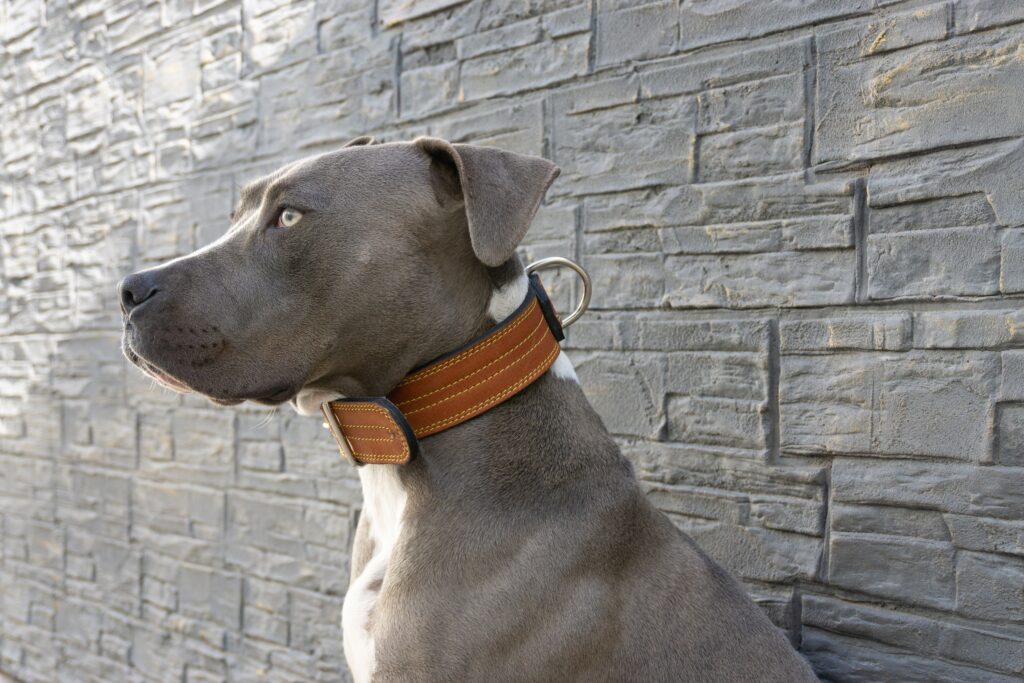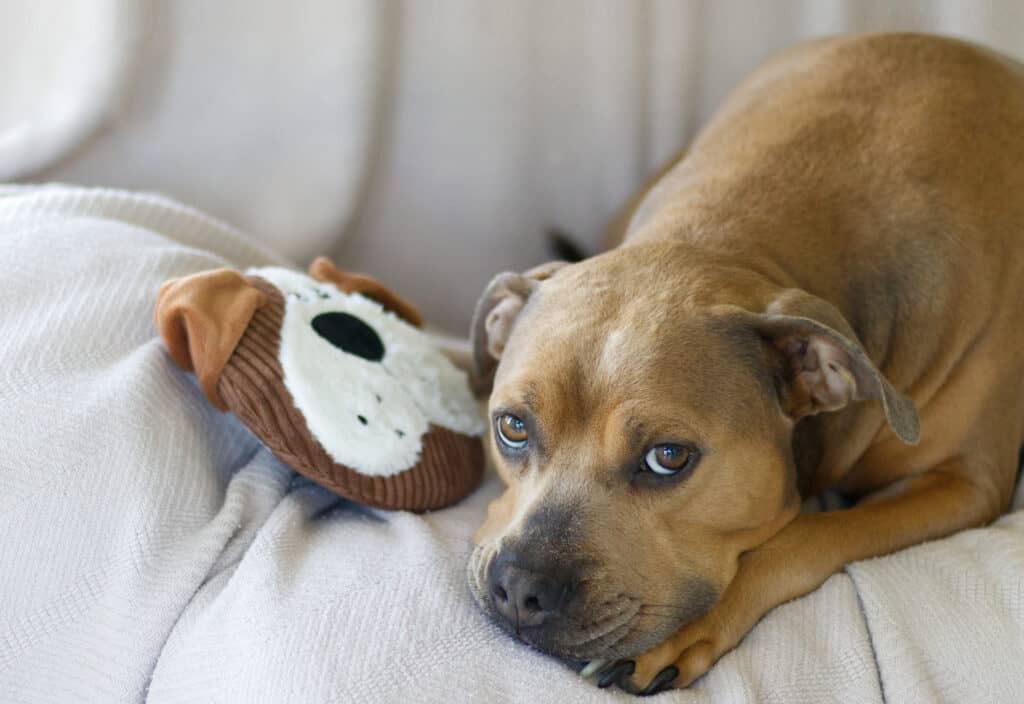Pitbulls are often considered very large dogs. However, both micro pitbulls and pocket pitbulls exist, though these terms aren’t easily definable. In this article, we’ll look at the difference between micro pit bulls vs. pocket pitbulls.
The term “pitbull” isn’t a dog breed at all. Instead, it is a category of breeds that includes several actual dog breeds, such as the American Pit Bull Terrier, the Staffordshire Bull Terrier, and the American Staffordshire Terrier.
Therefore, the “pitbull” term isn’t closely regulated. Many mixed breeds resemble the registered pitbull breeds and are labeled as “pitbulls,” even if this isn’t technically a dog breed. It’s not easy to identify a breed’s origin when it comes into a shelter, which leads to confusion regarding what a “pitbull” is.
What is a Micro Pitbull?

Micro pitbulls are often bigger than people think, especially given that their size can vary so much.
©Juan Pablo Axia/Shutterstock.com
Micro Pitbulls are often American Pit Bull Terriers bred to be smaller. Often, these dogs are not registered, as kennel clubs don’t recognize them. Therefore, they’re often not in dog shows and tend to be rare. They’re bred specifically as companion animals.
Often, these dogs weigh between 25 to 30 pounds and stand between 12 to 16 pounds. However, there is no recognized standard for their size, so exactly how big a micro pitbull is may vary from breeder to breeder. They’re often noticeably smaller than full-sized pitbulls, though.
Despite their smaller size, they often retain the familiar muscular, athletic build that is a distinguishing characteristic of the pitbull. Their coat color varies substantially, though.
Training and Socialization
Micro pitbulls do best with consistent, positive training methods. They are often eager to learn and decently intelligent. However, they can also be hyperactive. It is best to keep them well-exercised to prevent misbehavior. They can often learn a wide range of commands.
Socialization is vital to prevent behavior problems. These dogs must learn how to act around other humans in a range of weird situations. Start as early as possible to prevent behavioral problems like shyness and aggression.
Temperament
They tend to be very friendly, affectionate, and energetic dogs. They’re very suitable companions for active individuals and families. If you’re looking for more of a cuddle buddy, then this dog probably isn’t your best option. Be sure to train and socialize them from a young age to ensure their hyperactivity is channeled.
They are terriers and will act like terriers – even if they don’t look much like one.
These canines are also known for being loyal and people-driven. They prefer to hang around with their humans as much as possible. Therefore, they do best for those who have plenty of time to spend with them.
What Are Pocket Pitbulls?

The line between pocket pitbulls and micro pitbulls isn’t particularly clear.
©Cheryl Ann Studio/Shutterstock.com
Pocket pitbulls are a lot like micro pitbulls. They are not a recognized variant, which means any breeder can use the term. There are no official weight standards or breed profiles that breeders must follow.
These dogs normally have a compact size, stocky build, and a powerful appearance. They look and act like pitbulls. However, they are often smaller and weigh between 35 to 60 pounds. They stand around 12 to 17 inches tall at the shoulder.
However, the size actually varies widely, as we’ve explained. There is no definite range that breeders use to define these dogs.
Origin
The pocket pitbull was developed utilizing selective breeding aimed at creating a more compact version of the American Pitbull Terrier. However, exactly how this breed was developed is unknown. Different breeders develop it in different ways.
In some cases, they utilize only smaller American Pitbull Terriers, which slowly produce a smaller dog. Other times, they utilize smaller breeds similar to this breed, including the English Bulldog and French Bulldog.
Therefore, these dogs do vary depending on how the breeder created them. Adding the genetics of another breed can significantly alter a dog’s needs and temperament.
Training and Socilaization
These canines are terriers through and through. Therefore, they tend to be a bit hyperactive and may have trouble responding in high-stress, exciting situations. They require firm, consistent training in a range of settings to ensure they can listen to a command when they need to.
Just because a dog responds in your quiet home doesn’t mean they will when out in public.
Luckily, these dogs are eager to please and bond heavily with their owners. Therefore, they are often easy to train – they just require a lot of it. Keeping these dogs well exercised also helps prevent misbehavior, as it provides them something to do with all of their excess energy.
Temperament
Pocket pitbulls often exhibit similar traits to their larger counterparts. However, if other breeds were utilized to create them, then their traits may be slightly different.
They’re often quite friendly and affectionate, making them a great option for families. They desire to spend as much time with their humans as possible, so they do best when their families are home with them for much of the day.
Of course, they do tend to be a little protective in some cases. Socialization can help prevent this, though. Introducing them to many people and situations can prevent them from being fearful and interpreting non-threats as threats.
Luckily, these dogs tend to be pretty adaptive, allowing them to thrive in a range of different environments. Providing them with enough mental stimulation and exercise is necessary to keep them well-behaved, though. Without proper exercise, their energy can turn into hyperactivity.
Differences Between Micro Pitbulls vs. Pocket Pitbulls
Micro pitbulls tend to be a bit smaller than pocket pitbulls. Usually, micro pitbulls weigh between 25 to 50 pounds, while pocket pitbulls are between 35 to 60 pounds. As we’ve discussed, the exact weight can vary, though. It’s important to ask for a possible weight range when adopting a puppy to figure out exactly what size dog the breeder is selling.
Both of these dogs have similar temperaments. However, because they are smaller, micro pitbulls are more likely to have other breeds mixed into their genetics. These extra genes can affect their temperament. Ask your chosen breeder how the dogs were made to be so small.
Pocket pitbulls may be slightly more challenging to handle as they can be a bit bigger. However, proper training can be exceptionally helpful in this regard. Neither dog is particularly more trainable, either.
Big differences in both breeds may exist between different breeders. It’s important that responsible breeding choices are utilized. Avoid backyard breeders and puppy mills, and always ask to see the parents of the puppy. If the parents cannot be visited, there is usually a nefarious reason behind it.
Smaller dogs are often more prone to health issues, especially if they were made smaller using unhealthy dogs. Therefore, choosing a quality breeder is even more important for these dogs.
Choosing the Right Pitbull for You: Micro Pitbull vs. Pocket Pitbull
When considering which breed to choose, there are several considerations to keep in mind. For instance, if you have a very small living space, you should probably pick a smaller dog. Often, the micro pitbull falls into this category. (But this isn’t always the case.)
Micro pitbulls may also need a little less exercise because they are smaller. However, it’s more so that their smaller legs make it easier to exercise them – not that they require fewer steps or minutes of exercise.
Both breeders are capable family dogs, as that is the primary reason they are bred. They also require a similar amount of training and socialization.
In the end, the main difference is their size. However, even that varies a lot between breeders. For this reason, you’ll often see these terms used interchangeably. After all, if you have a 30-pound dog, is it a micro pitbull or a pocket pitbull? Technically, it would be both.
Summary of Micro Pitbull vs. Pocket Pitbull
| Aspect | Micro Pitbulls | Pocket Pitbulls |
|---|---|---|
| Size Range | 25 – 50 lbs, 12 – 16 inches | 35 – 60 lbs, 12 – 17 inches |
| Physical Features | Stocky, muscular build | Stocky, muscular build |
| Breeding Goals | Smaller size | Smaller size |
| Temperament | Energetic, loyal, protective | Balanced, adaptable, loyal |
| Exercise Requirements | Moderate | Moderate |
| Grooming Needs | Moderate | Moderate |
| Training Approach | Consistent and positive | Consistent and positive |
| Socialization | Essential | Essential |
| Living Space | Suitable for smaller homes | Very adaptable |
| Family Compatibility | Very good | Very good |
| Health Considerations | Potential size-related issues | Potential size-related issues |
The photo featured at the top of this post is © Petra Richli/iStock via Getty Images
Ready to discover the top 10 cutest dog breeds in the entire world?
How about the fastest dogs, the largest dogs and those that are -- quite frankly -- just the kindest dogs on the planet? Each day, AZ Animals sends out lists just like this to our thousands of email subscribers. And the best part? It's FREE. Join today by entering your email below.
Thank you for reading! Have some feedback for us? Contact the AZ Animals editorial team.






